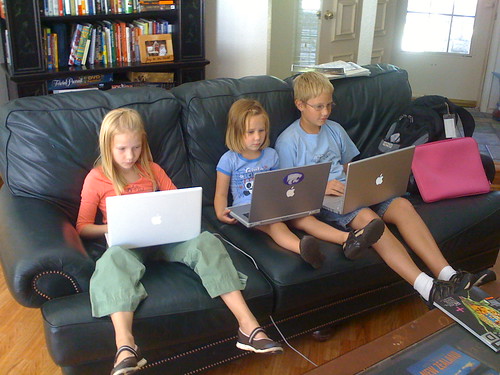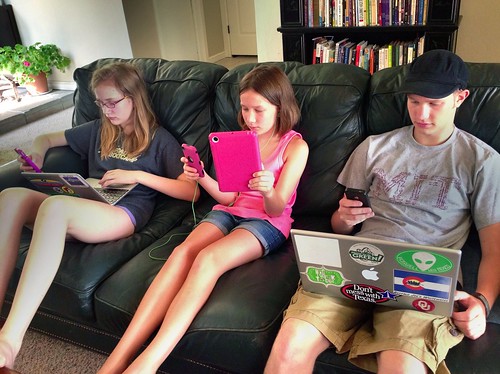Thoughts on Content Filtering, Parent Education, and School Laptop Initiatives
Author: Wesley Fryer
Go to Source
The Oklahoman, our largest Oklahoma City based newspaper by circulation, published a scathing article today about Norman Public Schools’ new MacBook Air and iPad “1 to 1 Learning” initiative. The article is titled, “‘They want them gone’: Norman parents complain of school devices.” In case The Oklahoman puts this article behind their paywall as they often do by the time you read this post, here is a link to an Internet Archive Wayback Machine copy. For those of you unfamiliar with our local geography, Norman is a city / community just south of OKC and part of our metro area of around 1.2 million folks, where the University of Oklahoma is located. The short summary of this article, which included quotations from 1.5 hours of parent complaints at this week’s Norman Public Schools board meeting, is that parents are mad because:
- Their students are accessing pornography at school and home on school-provided devices
- Their students are on their screens more than ever / screentime is increasing
- Their taxes have gone up and less expensive devices (implied: Chromebooks) could have been purchased.
Here are a few thoughts about this article and the issues it raises.
Internet Content Filtering at School and Home
Internet content filtering both at school AND at home for school-owned devices is essential. My November 2007 blog post, “One to One Initiatives (roundtable at TechForum07)” included my notes on a discussion about a Texas Immersion Pilot Project (TxTIP) school which had a similar situation: A sixth grader with a MacBook laptop was addicted to pornography, and the parent blamed the school. A school board member / trustee used this situation to try and cancel / derail the entire 1:1 learning project. Yes, that was 12 years ago. This is a critical lesson about the importance of ON AND OFF campus Internet filtering for all K-12 school-owned devices.
These kinds of school as well as home Internet filtering solutions are now available from a variety of vendors. Securly, which owns the iPad Mobile Device Management (MDM) platform we use at our school, also offers a comprehensive web content filtering solution that works on school-owned devices (MacOS/Windows laptops, iPads, or Chromebooks) regardless of whether they are used at school, home, or elsewhere. I have heard good things about Securly’s filtering solution several places, including the GSFE Admin’s Podcast. (GSFE = GSuite for Education)
It’s important to recognize and repeatedly communicate, to parents, teachers, and community members, that NO FILTERING SOLUTION can guarantee students will not ever see or encounter offensive / inappropriate content online. An increasing number of K12 schools, especially high schools, are adopting BYOD (bring your own device) laptop programs instead of providing school-owned devices to students. For those programs, schools generally CANNOT (and from a liability standpoint, do not want to) provide built-in filtering software protection on parent / family / student owned devices which works off the school campus. Every school provides on campus Internet content filtering, but is limited in BYOD situations when students access the web from home / away from school.
In addition, let’s not ignore the fact that a significant majority of secondary students today possess and use a smartphone. Pew Research reported in August 2019 that 95% of US teens now report they have access to a smartphone. While some parents do enable smartphone parental controls for teens, like those available now for iPhones, and others purchase and configure content filtering solutions like Disney’s Circle Go which work everywhere (both at home and school / away from home) many parents do not. Therefore, a LARGE number of teens today have access to parent-provided Internet connected devices which are NOT filtered or otherwise restricted in what they can access.
Parents are, in many cases, frustrated by the lack of control they feel when it comes to screens and Internet content. However, schools should not be blamed for the proliferation of smartphones in our society. Even for families which choose to not provide a smartphone to their teens or delay smartphone ownership till high school, most of their teen’s peers at school today DO have smartphones and access to all the challenges that entails. We’re swimming in a digital world, and it’s almost impossible not to get wet. We all need to learn to swim safely and responsibly, and that takes partnerships as well as ongoing vigilance by parents as well as educators and students themselves.
Offensive Internet Content, Screentime and Parent Education
The complaints quoted in this article could likely have been shared by at least some parents in any school, public or private, which has adopted a “1 to 1” or digital learning initiative with laptops or tablets in which students use digital devices individually and (at some point / grade level) take them home. Sadly, online pornography is more common and easily accessible than ever. We live in a “seek and find world,” where the barriers to offensive media / content are lower than ever for anyone with an unfiltered / unrestricted Internet connection. But “adult pornography” as we may understand it is unfortunately far from the worst content that is just a few clicks for anyone who wants to find it. The September 2019 New York Times article, “The Internet Is Overrun With Images of Child Sexual Abuse. What Went Wrong?,” offers an important window into this reality which tragically is only getting worse as we move further into the twenty-first century.
Screentime has now eclipsed parental concerns about Internet predators in many schools and communities. It is a fact of life today that as we receive and share more of our information with digital devices, our aggregate time in front of screens increases. But “screentime” is not and should not be treated as a pariah and new bogeyman. Another recent New York Times article, this one from December 2019 titled, “Is Screen Time Really Bad for Kids?,” does a good job explaining why we need to STOP talking about screentime as if it is MONOLITHIC. It is not. Binge watching Netflix or YouTube, or playing a first-person shooter videogame, is cognitively very different than CREATING a video, making digital art, or even reading the Holy Bible. All of these things can be done with a screen, but their impact on our thinking, cognitive abilities, and relationships can be very different. If you’re looking for an excellent, balanced book to read and recommend to parents on Screentime, check out “The Art of Screen Time: How Your Family Can Balance Digital Media and Real Life” by Anya Kamenetz (@anya1anya).
So what does “best practice” parent education for a digital learning initiative look like? From the “iTech” website of Norman Public Schools as well as conversations I’ve had with Norman schools technology staff, it looks like they’ve been offering a variety of different parent digital education opportunities available throughout the school year. As an example, here is a 28 minute video of an October 2019 presentation for high school parents in Norman, “iTech Parent Academy – iTech 101.” Many more videos are available on the Norman PS iTech Parent Academy webpage.
Balance and Partnerships Are Essential
I appreciate the fact that the author of this Oklahoman article, Nuria Martinez-Keel (@NuriaMKeel), live-tweeted the Norman Public Schools board meeting she summarized in today’s article. She did include a few quotations from the district superintendent, but she did not mention or identify any of the parent education programs or initiatives which I’ve highlighted in this post after a quick Google search.
Unfortunately The Oklahoman newspaper (also known as “The Daily Oklahoman” and previously newsOK.com) has historically been an antagonistic editorial voice for public education and public schools in our state. Compared to the Tulsa World, The Oklahoman has more often championed voucher proposals and charter schools rather than advocating for our public schools. Ideally journalists and news organizations are neutral and unbiased, but we know more clearly than ever today in our era of hyper-partisanship this is sometimes not the case.
Balanced discussions of issues like those raised in this article are important, as are partnerships with parents and schools: both public and private. As a comparison, I encourage you to read the October 2019 article from Washington State, “Pierce County schools spending millions on laptops for all. Is it helping kids learn?.” That article includes perspectives and quotations for advocates as well as critics of the local school district’s extensive and expensive laptop learning project, and also includes helpful information about district policies, programs, as well as related educational research. It’s a much more balanced article on the subject of laptop learning.
If there is one thing we do NOT need in our nation right now, it’s more polarizing journalism. There are definitely issues about which we need to advocate and work passionately, but there are also situations which need and deserve balanced media coverage. The role of our mainstream national and local media outlets (our “fourth estate”) in educating citizens and voters on issues is vital. Hopefully we’ll see more balanced reporting on the Norman Public Schools laptop learning initiative by The Oklahoman in the weeks to come.
At the end of the day, our schools and teachers not only need to keep students safe and help them develop knowledge and skills, they/we also need to prepare students to THRIVE and be successful in the future. While some people may opt to conscientiously object and entirely disconnect from our increasingly digital economy and society, most of us will not have that option outside weekend or summer camping trips. Learning to responsibly make choices on how to engage in focused work despite the maelstrom of digital distractions whirling all around us is a duty for 21st century schools and parents. We need to partner together in these efforts, because while they are not easy, they ARE challenges we need to rise TOGETHER to meet.
Check out resources related to screentime, Internet safety, and digital parenting on our school’s website for digital citizenship: DigCit.us.
If you enjoyed this post and found it useful, consider subscribing to Wes’ free, weekly newsletter. Generally Wes shares a new edition on Monday mornings, and it includes a TIP, a TOOL, a TEXT (article to read) and a TUTORIAL video. You can also check out past editions of Wes’ newsletter online free!
Did you know Wes has published several eBooks and “eBook singles?” 1 of them is available free! Check them out! Also visit Wes’ subscription-based tutorial VIDEO library supporting technology integrating teachers worldwide!
MORE WAYS TO LEARN WITH WES: Do you use a smartphone or tablet? Subscribe to Wes’ free magazine “iReading” on Flipboard! Follow Dr. Wesley Fryer on Twitter (@wfryer), Facebook and Google+. Also “like” Wes’ Facebook page for “Speed of Creativity Learning“. Don’t miss Wesley’s latest technology integration project, “Show With Media: What Do You Want to CREATE Today?“



